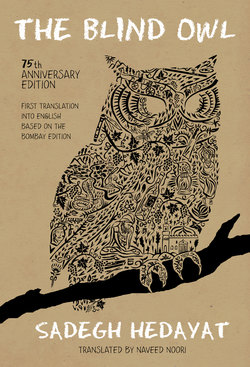Читать книгу The Blind Owl (Authorized by The Sadegh Hedayat Foundation - First Translation into English Based on the Bombay Edition) - Sadegh Hedayat - Страница 7
На сайте Литреса книга снята с продажи.
The Bombay Edition as the Definitive Edition
ОглавлениеWhile some of the individual points I have made above (such as the changing verb tenses) could be argued as the author’s wishes, the main difference in the texts is the preponderance of extremely minute changes, such as single punctuation or letter changes within words to form a different tense or different word. This is suggestive of typesetting errors rather than artistic decisions by Hedayat. Some of these changes clearly have a negative impact on the text and affect the flow, and perhaps are one reason Hedayat’s writing style has been faulted by some.
One possibility that I can not exclude is that Hedayat could have made some of these minor changes and handed it over to the typesetter who introduced a series of errors. However, as noted above, there is no evidence that Hedayat ever revised The Blind Owl after the Bombay edition.
Finally, this case is very similar to Nathaniel Hawthorne’s The House of the Seven Gables.1 In examining the manuscript and first printed edition Bowers writes:
When an author’s manuscript is preserved, this has paramount authority, of course. Yet the fallacy is still maintained that since the first edition was proofread by the author, it must represent his final intentions and hence should be chosen as copy-text. Practical experience shows the contrary. When one collates the manuscript of The House of the Seven Gables against the first printed edition, one finds an average of ten to fifteen differences per page between the manuscript and the print, many of them consistent alterations from the manuscript system of punctuation, capitalization, spelling, and word-division. It would be ridiculous to argue that Hawthorne made approximately three to four thousand small changes in proof, and then wrote the manuscript of The Blithedale Romance according to the same system as the manuscript of the Seven Gables, a system that he had rejected in proof.
A close study of the several thousand variants in Seven Gables demonstrates that almost every one can be attributed to the printer. That Hawthorne passed them in proof is indisputable, but that they differ from what he wrote in the manuscript and manifestly preferred is also indisputable. Thus the editor must choose the manuscript as his major authority. . . .
In summary, as of today, we only have two main versions, the Bombay which we know was Hedayat’s as it is handwritten and the later texts, which upon close examination were found to have many inaccuracies. For the reasons stated above, the Bombay edition should be considered the definitive version. This view is also shared by Hedayat scholar M. F. Farzaneh as well as the Hedayat Foundation, both of whom have published the Bombay edition for this reason.1,2
